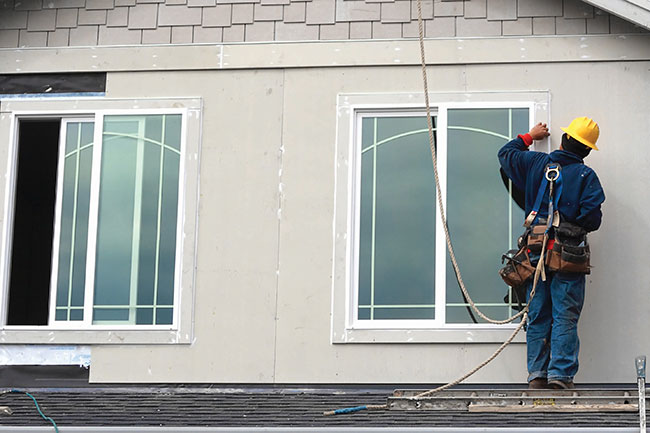
Articles
Business Intelligence
Safety certified
Certificates of Recognition are a growing part of the industry landscape.
October 21, 2021 By Treena Hein
 COR-certified companies send the message that they take safety seriously and therefore fare better in the labour market.
Photo credit: © AlterYourReality / iStock
COR-certified companies send the message that they take safety seriously and therefore fare better in the labour market.
Photo credit: © AlterYourReality / iStock Each year in Canada, the Certificate of Recognition (COR) safety program becomes more well known and a little more widespread in the construction industry. Window and door manufacturers and installers may choose to become COR-certified for a variety of important reasons.
Start with a quick look at the program. COR accreditation verifies that companies are meeting national occupational health and safety standards. It began in Alberta more than 20 years ago. It’s overseen by the Canadian Federation of Construction Safety Associations but implemented by provincial agencies such as the BC Construction Safety Alliance (which also serves as the current contact for CFCSA inquiries.)
COR aims to provide employers with an effective safety and health management system to reduce safety incidents, accidents and injuries as well as their associated human and financial costs. Its effectiveness at lowering injury rates has been proven though recent independent impact evaluations in B.C., Alberta and Saskatchewan conducted by researchers at the University of British Columbia School of Population and Public Health in collaboration with BCCSA and WorkSafeBC (see CFCSA website for the research briefs).
To achieve COR certification, companies must demonstrate many aspects of workplace health and safety, culminating in an external audit, including policies and procedures, training, hazard assessment, emergency response and incident investigation. Companies must train their own internal auditors to ensure compliance between external audits (generally every three years).
A range of benefits
The benefits of COR certification are many for anyone involved in residential construction, including lower annual insurance premiums. In Alberta, for example, COR (or SECOR, Small Employer COR) qualifies employers for Workers Compensation Board premium rebates of up to 20 percent. And, in B.C., with COR certification, a company scores a 10 percent rebate from WorkSafeBC. “Over time,” adds BCCSA director of COR and injury management Vernita Hsu, “with lower injury rates and lower claim costs, insurance premiums will reflect additional savings.”
In Ontario, COR is being migrated to COR 2020 to help workplaces qualify for financial rewards and recognition from the Ministry of Labour, Training and Skills Development and the Workplace Safety and Insurance Board. COR2020 has a new format and the audit tool has a reduced number of elements.
COR-certified companies might also have an easier time with recruiting tradespeople. “In an increasingly competitive labour market, where workers have more options for employment, they will choose to work for companies who have their best interests at heart,” Hsu explains. “If you have the option of working for an employer that has a system in place that will ensure you have a close-to-20-percent-better chance of avoiding injury and, more importantly, serious injury – all things being equal, the choice becomes obvious.”
COR is also a practical way of demonstrating to customers and the public that you take safety seriously, adds Hsu. “COR certification makes a strong statement about a company’s commitment to protecting the well-being of workers and maintaining a culture of safety on jobsites,” she says. “Having a third-party audited system shows the world that someone beyond the company thinks your safety system is ‘good.’”
Beyond all these benefits is the fact that COR certification is becoming a requirement of doing business on larger projects. COR is now frequently used as a pre-qualifying and/or condition of contract by both public and private project owners across Canada. Indeed, in part because more of these owners consider COR preferential for bidding purposes or in some cases a pre-requisite, COR participation in B.C. has increased substantially in recent years, almost doubling since 2010.
Sobi Ragunathan, an external COR auditor for the Infrastructure Health and Safety Association (which administers COR in Ontario) at 4S Consulting Services in Markham, Ont., notes that there is a huge demand for COR certification across Ontario. She says many municipal infrastructure projects require COR certification or to be ISO 45001 registered for bidding. “It began with the city of Toronto,” she notes, “and has expanded from there.”
So, to make sure a bid is successful, larger contractors increasingly only want subcontractors that are also COR-certified. In addition, having everyone on the jobsite COR-certified means that every worker’s health and safety activities are aligned.

COR is already an assumed requirement on commercial jobsites. But residential builders are starting to look for it, too.
Photo credit: © Iam Anupong / Getty Images
Uptake and more in Manitoba
Adoption of COR has been very successful among residential contractors in Manitoba. The Construction Safety Association of Manitoba began promoting COR among smaller contractors for many years by offering practical resources, including associated checklists and guides. “Now, over half the payroll in construction in Manitoba is COR-certified and, for redential construction, COR is required to be a member of the Manitoba Home Builders Association,” notes CSAM executive director Sean Scott, who also chairs the CFCSA National Technical Committee and COR Committee. “Overall, about 1,000 building construction companies are COR certified in Manitoba, and 39 percent of those have 10 or fewer employees. Once achieving this prestigious designation, almost 100 percent of all companies maintain their COR certification year after year.”
Scott notes that financial incentives definitely play a role in becoming COR-certified, but they are only one of the benefits. “In 2020, we had about $2 billion in construction payroll in Manitoba and $3.5 million in prevention rebates provided to COR-certified employers,” he reports. “In 2019, severe injuries were reduced by 14.4 percent from the year before and that’s directly influenced by COR certification. It’s an established and creditable program that results in fewer time-loss incidents, improves morale and retention and provides a systematic approach to doing a job. It allows safety to become an integrated part of production, quality and efficiency.”
While the time to achieve COR certification will vary depending on the size and complexity of a contractor’s operations, Scott puts the minimum time at three to six months. The CSAM offers the required COR training courses every month, adaptable templates, personal consultation and more to ensure swift implementation. The cost is $775 for the required training and audit in the initial year of COR in Manitoba, and $550 for maintenance years.
“Our sense at the BCCSA,” says Hsu, “is that COR demand will continue to grow, particularly because the program has been empirically proven to reduce injuries. There is no other system that can claim that.”
Print this page
Leave a Reply